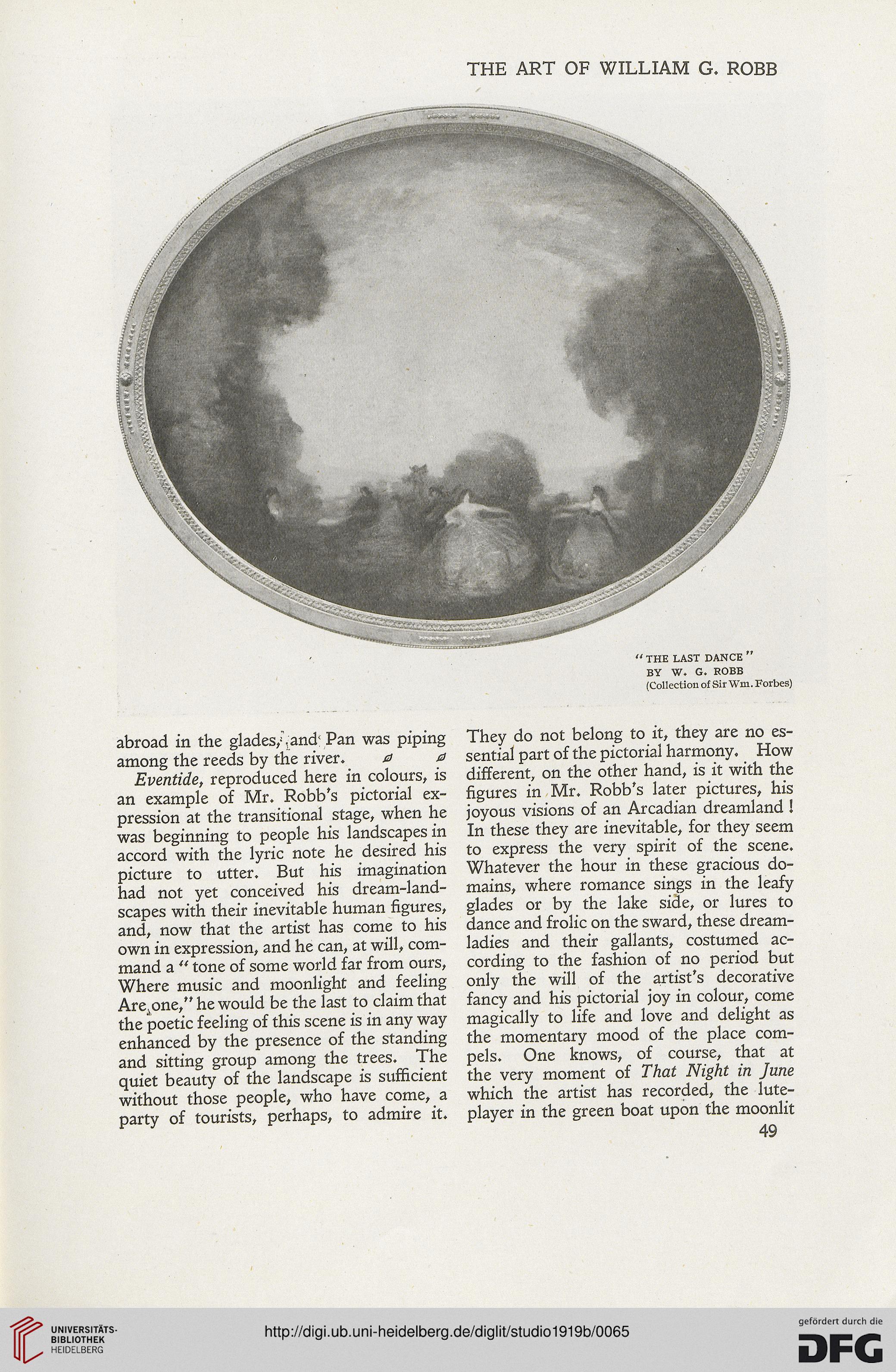THE ART OF WILLIAM G. ROBB
“ THE LAST DANCE "
BY W. G. ROBB
(Collection of Sir Wm. Forbes)
abroad in the glades,', and Pan was piping
among the reeds by the river. 0 a
Eventide, reproduced here in colours, is
an example of Mr. Robb's pictorial ex-
pression at the transitional stage, when he
was beginning to people his landscapes in
accord with the lyric note he desired his
picture to utter. But his imagination
had not yet conceived his dream-land-
scapes with their inevitable human figures,
and, now that the artist has come to his
own in expression, and he can, at will, com-
mand a “ tone of some world far from ours,
Where music and moonlight and feeling
Are^one,” he would be the last to claim that
the poetic feeling of this scene is in any way
enhanced by the presence of the standing
and sitting group among the trees. The
quiet beauty of the landscape is sufficient
without those people, who have come, a
party of tourists, perhaps, to admire it.
They do not belong to it, they are no es-
sential part of the pictorial harmony. How
different, on the other hand, is it with the
figures in Mr. Robb’s later pictures, his
joyous visions of an Arcadian dreamland !
In these they are inevitable, for they seem
to express the very spirit of the scene.
Whatever the hour in these gracious do-
mains, where romance sings in the leafy
glades or by the lake side, or lures to
dance and frolic on the sward, these dream-
ladies and their gallants, costumed ac-
cording to the fashion of no period but
only the will of the artist's decorative
fancy and his pictorial joy in colour, come
magically to life and love and delight as
the momentary mood of the place com-
pels. One knows, of course, that at
the very moment of That Night in June
which the artist has recorded, the lute-
player in the green boat upon the moonlit
49
“ THE LAST DANCE "
BY W. G. ROBB
(Collection of Sir Wm. Forbes)
abroad in the glades,', and Pan was piping
among the reeds by the river. 0 a
Eventide, reproduced here in colours, is
an example of Mr. Robb's pictorial ex-
pression at the transitional stage, when he
was beginning to people his landscapes in
accord with the lyric note he desired his
picture to utter. But his imagination
had not yet conceived his dream-land-
scapes with their inevitable human figures,
and, now that the artist has come to his
own in expression, and he can, at will, com-
mand a “ tone of some world far from ours,
Where music and moonlight and feeling
Are^one,” he would be the last to claim that
the poetic feeling of this scene is in any way
enhanced by the presence of the standing
and sitting group among the trees. The
quiet beauty of the landscape is sufficient
without those people, who have come, a
party of tourists, perhaps, to admire it.
They do not belong to it, they are no es-
sential part of the pictorial harmony. How
different, on the other hand, is it with the
figures in Mr. Robb’s later pictures, his
joyous visions of an Arcadian dreamland !
In these they are inevitable, for they seem
to express the very spirit of the scene.
Whatever the hour in these gracious do-
mains, where romance sings in the leafy
glades or by the lake side, or lures to
dance and frolic on the sward, these dream-
ladies and their gallants, costumed ac-
cording to the fashion of no period but
only the will of the artist's decorative
fancy and his pictorial joy in colour, come
magically to life and love and delight as
the momentary mood of the place com-
pels. One knows, of course, that at
the very moment of That Night in June
which the artist has recorded, the lute-
player in the green boat upon the moonlit
49




